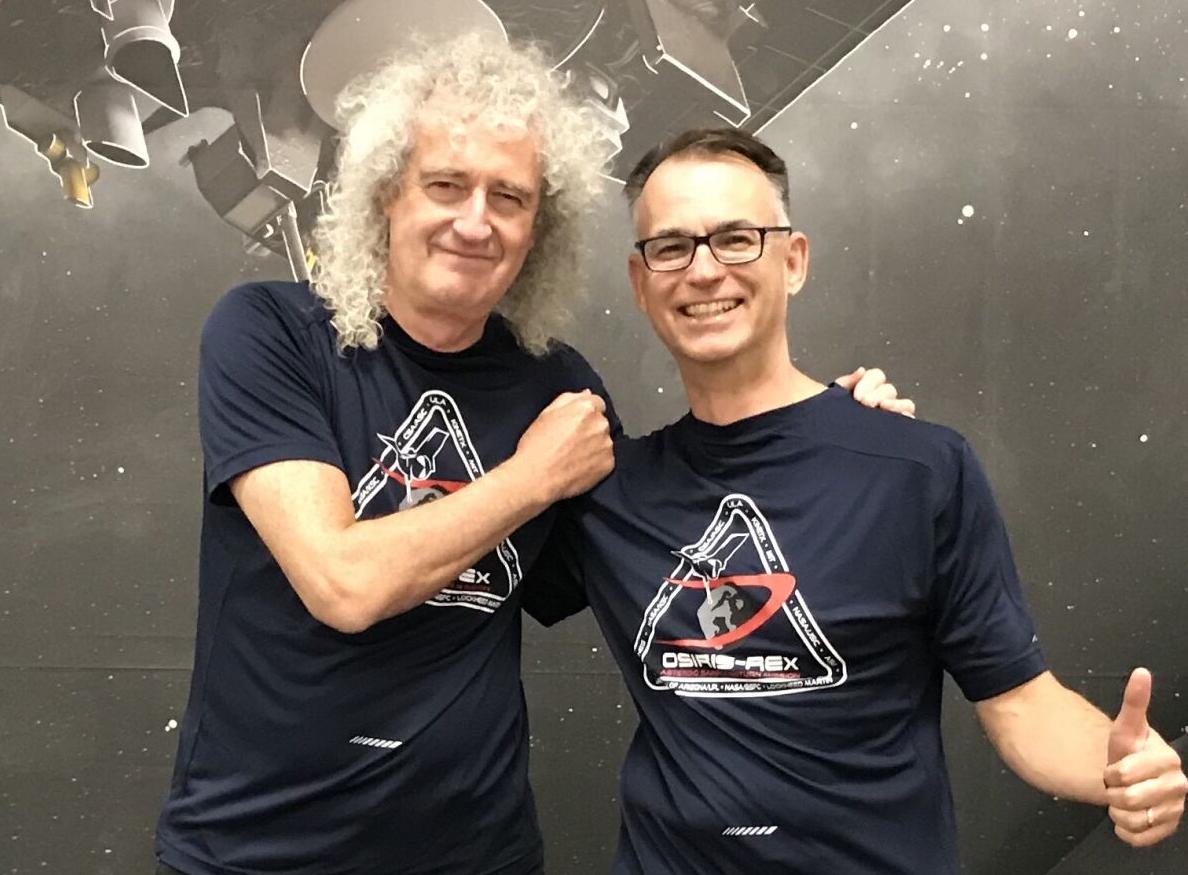Arizona’s top man on NASA’s asteroid sampling mission has teamed up with actual rock ’n’ roll royalty to write the book on Bennu.
Set for release on Thursday, “Bennu 3-D: Anatomy of an Asteroid” uses images and data from the University of Arizona-led OSIRIS-REx mission to create what is being described as the world’s first complete — and three-dimensional — atlas of an asteroid.
The book was co-authored by UA professor and OSIRIS-REx principal investigator Dante Lauretta and Brian May, a Ph.D. astrophysicist also known for his other job as lead guitarist and founding member of the rock band Queen.
In Lauretta’s preface to the book, he recalls first meeting the rock star through a mutual friend in the space science world in 2016, a few months before OSIRIS-REx was launched.
“Brian and I corresponded briefly about the mission and my hometown of Tucson, Arizona, where he had spent some time enjoying the natural beauty of the Sonoran Desert and using it for self-reflection, as many do,” he writes.

Queen guitarist Brian May performs during the Platinum Jubilee concert taking place in front of Buckingham Palace in London on June 4, 2022. May was knighted by Britain’s King Charles III earlier this year.
Lauretta was already quite familiar with May’s work outside of astrophysics, particularly the song “Under Pressure,” which he says helped him through some tough times as a kid.
“I was, of course, a huge fan of Brian’s music,” he writes. “The fact that I was corresponding with one of my childhood heroes was beyond cool.”
They finally met in person in 2017 when May invited Lauretta and his family to join him backstage at a Queen concert in Phoenix. The two kept in regular contact after that.
“As the OSIRIS-REx mission progressed, I couldn’t help but share some of the latest developments with him,” Lauretta writes. “To my delight, Brian showed a keen interest in the mission and the science behind it. It was clear that he was not just a casual fan, but a true space enthusiast and an advocate for space exploration.”
May ended up playing an important role in the asteroid sampling effort.
He and his collaborator, Claudia Manzoni, used early, publicly available data collected by the spacecraft to produce stereoscopic images that showed Bennu’s rugged and dangerous landscape in what Lauretta describes as “glorious 3-D.”
Producer Dan Gallagher and data visualizer Kel Elkins discuss the making of a video called “Tour of Asteroid Bennu” and how data-driven animation is enabling viewers to explore new worlds.
The images were so detailed and daunting that researchers began to worry that they might not find a safe place for their spacecraft to touch down among Bennu’s jumble of boulders.
Lauretta soon offered May and Manzoni formal positions on the OSIRIS-REx science team, with full access to all the mission’s data.
There was nothing casual or honorary about the invitation. “OSIRIS-REx is serious business,” Lauretta writes, “and I was not interested in tourists joining the team simply because they were celebrities.”
May and Manzoni would go on to produce countless stereo images of Bennu’s terrain that helped the team identify small craters filled with fine-grain material for the spacecraft to safely sample, which it famously did on Oct. 20, 2020.
The new book highlights 80 of those 3D images, including some that are being published for the first time. It comes with a pair of May-designed Lite Owl stereoscopic viewers to see the pictures as they were intended to be seen.

The new 3D atlas of asteroid Bennu will be released on July 27.
The $50 book also features 120 illustrations and 50 maps of the asteroid.
“Bennu 3-D” is co-published by The University of Arizona Press and May’s London Stereoscopic Company. Fellow co-authors include Manzoni, imaging engineer Carina Bennett, planetary geologist Ken Coles and science editor Cat Wolner.
May studied physics and mathematics in his 20s at Imperial College London, but his doctoral work was interrupted in 1974 by the growing success of the band he started with singer Freddie Mercury and drummer Roger Taylor four years earlier.
After a Rock and Roll Hall of Fame career, he returned to Imperial College in 2006 to finish his Ph.D. thesis on bands of interplanetary dust known as the zodiacal cloud.
The newly minted doctor of astrophysics would go on to help found a global awareness campaign called Asteroid Day, author several books about space and stereoscopy, and serve as a science team collaborator on NASA’s New Horizons spacecraft as it flew past Pluto.
Since then, he has produced 3D stereo images of solar system objects using data from New Horizons, OSIRIS-REx and the Japanese space agency’s Hayabusa2 asteroid sampling probe.
More research is needed, but May is almost certainly the only astrophysicist and Grammy Lifetime Achievement Award winner who is also a knight with an asteroid named after him.
Early this year, King Charles III knighted May for his contributions to music and charity, including his Save Me Trust dedicated to protecting wildlife.

Brian May of Queen performs with Adam Lambert, front center, at the 2019 Oscars ceremony at the Dolby Theatre in Los Angeles.
The scientist and guitar legend, who turned 76 on Wednesday, hopes the new book on Bennu will appeal both to experts and laypeople.
Producer Dan Gallagher and data visualizer Kel Elkins discuss the making of a video called “Tour of Asteroid Bennu” and how data-driven animation is enabling viewers to explore new worlds.
“The OSIRIS-REx mission undertook by far the most intimate exploration of any asteroid to date, and here are the results, the fruits of the labours of a huge team of top scientists and engineers,” May writes on his website. “Our aim has been to deliver this extraordinary portrait in a form which is understandable and enjoyable to scientists and non-scientists alike.”
May and Lauretta will officially launch their collaboration on July 31 during a sold-out virtual event at London’s famed Natural History Museum, where they will talk about asteroids and show off stereoscopic photos of Bennu.
To experience the images in all their glory, the museum is encouraging those who attend the event in person or stream it online to get themselves a pair of special 3D viewers, designed by Sir Brian May himself, of course.
Queen's 'Greatest Hits' is the best-selling album of all time.








